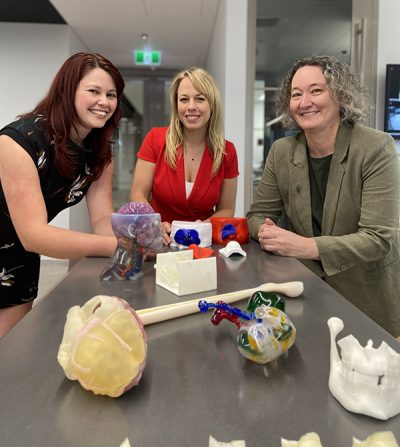HBI’s 3D printing and modelling improves patient care
Herston Biofabrication Institute’s Cancer Care program is directly assisting Metro North Health patients, with its 3D printed devices being used to improve patient care outcomes in radiation dose accuracy and comfort.

The HBI Cancer Care program is developing 3D printed devices to improve radiation patient care outcomes
Through 3D scanning and 3D printing, the HBI Cancer Care team have been able to replicate the needs of specific patients in order to measure radiation doses exactly – closing the gap between modelled and delivered treatments and resulting in safer, more precise treatment for patients.https://metronorth.health.qld.gov.au/wp-admin/post-new.php#
Additionally, 3D printing is aiding in skin cancer treatment to optimise radiation doses and avoid unnecessary moulds using plaster or wax on painful cancerous lesions.
Royal Brisbane and Women’s Hospital Director of Medical Physics in Cancer Care Adjunct Associate Professor Tanya Kairn is working with a team of physicists, radiation therapists and radiation oncologists, to achieve positive results by using HBI’s 3D printing lab in both measurement as well as treatment.
“We can calculate the dose of radiation for the patient, and we can predict that dose, but we can’t directly measure it inside the patient,” Adjunct Associate Professor Kairn said.
“What we need is a really good replica of the patient, that includes all their different densities. The staff and equipment at HBI are helping us create very accurate 3D printed patient models for evaluating our most advanced radiotherapy treatments.
“Meanwhile for patients with skin cancer, radiation levels can sometimes build up in the underlying cancer while not delivering enough dose to the skin, where the cancer is coming from – so 3D printed boluses allow us to treat both the skin and the underlying cancer.
“While boluses have been used for years, this new 3D printed bolus is much more comfortable for a patient, as we do not need to manually create a wax or plaster mould on their painful and inflamed skin and can instead create this using a 3D surface scanner or standard medical images.”
Over 100 patients have benefited from the 3D printed boluses across Metro North Health so far, with clinical application expected to continue growing across cancer care.
